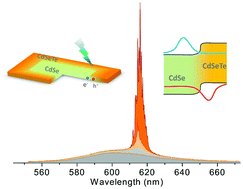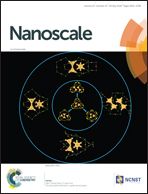Low-threshold lasing from colloidal CdSe/CdSeTe core/alloyed-crown type-II heteronanoplatelets†
Abstract
Colloidal type-II heterostructures are believed to be a promising solution-processed gain medium given their spatially separated electrons and holes for the suppression of Auger recombination and their wider emission tuning range from the visible to near-infrared region. Amplified spontaneous emission (ASE) was achieved from colloidal type-II core/shell nanocrystals several years ago. However, due to the limited charge-transfer (CT) interfacial states and minimal overlap of electron and hole wave functions, the ASE threshold has still been very high. Herein, we achieved ASE through type-II recombination at a lower threshold using CdSe/CdSeTe core/alloyed-crown nanoplatelets. Random lasing was also demonstrated in the film of these nanoplatelets under sub-ns laser-pumping. Through a detailed carrier dynamics investigation using femtosecond transient absorption, steady state, and time-resolved photoluminescence (PL) spectroscopies, we confirmed the type-II band alignment, and found that compared with normal CdSe/CdTe core/crown nanoplatelets (where no ASE/lasing was observed), CdSe/CdSeTe core/alloyed-crown nanoplatelets had a much higher PL quantum yield (75% vs. 31%), a ∼5-fold larger density of type-II charge-transfer states, a faster carrier transfer to interfaces (0.32 ps vs. 0.61 ps) and a slower Auger recombination lifetime (360 ps vs. 160 ps). Compared with CdSe/CdTe nanoplatelets, their counterparts with an alloyed crown boast a promoted charge transfer process, higher luminescence quantum yield, and smaller Auger rate, which results in their excellent application potential in solution-processed lasers and light-emitting devices.



 Please wait while we load your content...
Please wait while we load your content...